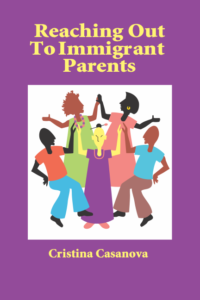
Welcoming families as vital partners in the school community can create a stimulating learning environment. It can also be frustrating and challenging, especially when social customs and mores, language differences, even fear become barriers that can hinder this partnership.
The Student Reality
In many cases, immigrant students prove surprisingly resilient and eager to mimic the behaviors and values of their American peers. Some come from countries where Western culture has already made significant inroads, whether through television, movies, music, technology or MacDonald’s. However, too rapid acculturation can often spell trouble at home, as conflicts develop between children intent on change and parents determined to preserve traditional values.
Linking with Parents
This book is about reaching out to immigrant parents because it is often the parents, not the students, who need the greatest understanding and help. School systems differ around the world. In many countries parent involvement is not expected, or wanted. Immigrant parents may not understand how the U.S. school system works and be totally unfamiliar with the concept of parent involvement. In addition to not understanding the school system they often have very little knowledge of how to support their children’s educational development.
Few children, regardless of culture, achieve their full academic, social and leadership potential without the support of a caring, involved family. Talented, able immigrant children can easily fall by the wayside if their parents are so alienated from the educational system that they are unable to assist with homework, language acquisition, and a whole array of compliance issues ranging from simple attendance to behavior codes and discipline policies. When parents are in overt (or covert) conflict with the educational system, the cultural tug-of-war for the mind and heart of the child can be devastating.
By extending a welcoming hand, making efforts to communicate, and involving immigrant parents in the schooling of their children, we can circumvent many of these problems. It’s a preventive approach, really, one that attempts to support and strengthen the child at the foundational level.
Building a Repertoire
As educators, we need to comprehend and address a complete range of cultural issues. To do this, we have to understand the values, customs and worldview of the dominant American culture as well as those of immigrant students and their families. We must be aware of the unique behaviors of each immigrant child, while appreciating and understanding the cultural context from which these behaviors originate. We should also try to understand the immigration experience and the process of acculturation — which is often painful and conflicting.
Cultural Factors to Keep in Mind
Understanding your own culture is a major step toward understanding others. It’s like anything else. Having a context and a basis for comparison makes identifying differences a lot easier. Remember that while values are the bedrock of culture, they often can only be understood by examining customs, communication styles and individual behaviors. The values themselves are hidden.
Communication styles and patterns, including body language, vary from one culture to another. For example, people from some cultures pull away in response to direct questioning or see “why” questions as accusations. Others feel an obligation to please the person with whom they are talking and think nothing of massaging the facts in order to do so. In some cultures, smiling and nodding have little to do with genuine pleasure or agreement. In others, having direct eye contact with someone in an authority position is considered rude.
In communicating with immigrant students and their families, it is important to do perception checks. Is your interpretation correct? Check with the other person. The rules for good listening and responding don’t change, but if you are willing and able to make small adjustments in your style of communicating (to more closely mirror the style of the other person), communication will be improved.
The more you know about a student’s culture, the better the chances of effective communication. This doesn’t mean that you have to devote hours of study to becoming multiculturally literate. Showing an interest in the diverse experiences of students and their families is an important way to build relationships. Observing, asking questions and exploring differences in an open and honest way will go a long way to building insight and understanding. For example, questions and observations may tell you such things as:
• The amount of personal space an individual requires. (This tells you how much physical distance to allow between you and the other person.)
• How time is viewed. Does the American expectation of punctuality have meaning in the other culture? Is the fast pace of American life creating conflicts for the student or family? Do children and their parents understand and accept the concept of deadlines and due dates for projects and papers?
• The family’s decision-making process. How does information seem to flow from the child to the home and back again to you? Is there an established protocol for gaining parent cooperation? Do family members other than parents (e.g., grandparents, aunts, siblings) need to be involved?
Gauge the amount of information you provide. This is particularly important when working with immigrant parents. Individuals experiencing culture shock are already overwhelmed. Piling on reams of information is probably going to be counterproductive. Prioritize what you need to convey to parents and then deal with it in small chunks. Have more contacts of shorter duration.
You can check the book out HERE.
If you like our blog resources and would like to receive them regularly, please subscribe here or on our website at www.InnerchoicePublishing.com
Thanks so much for reading!
Cristina Casanova (Author)
